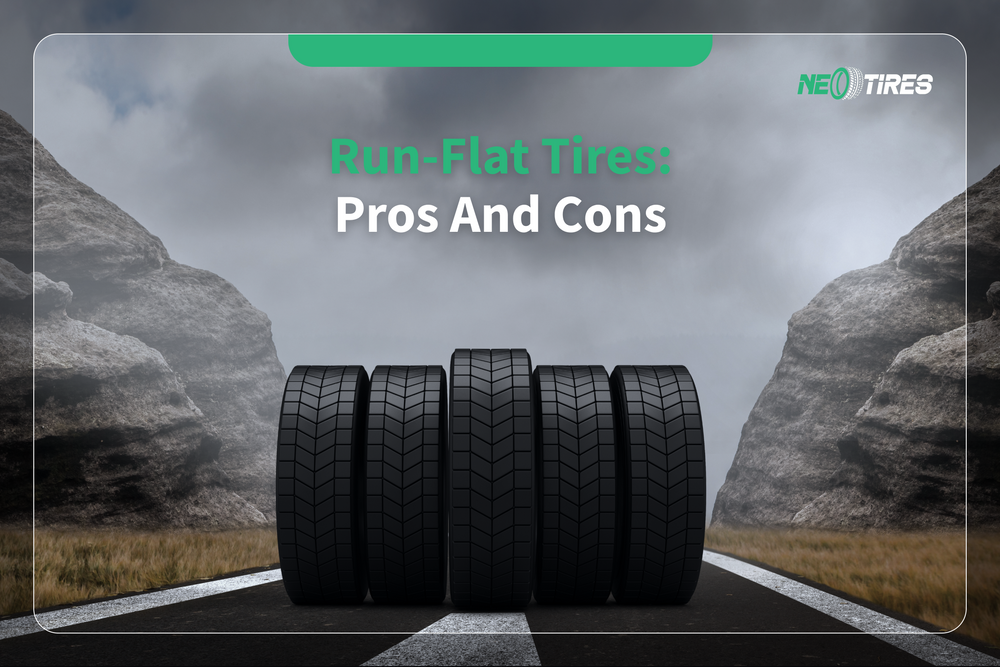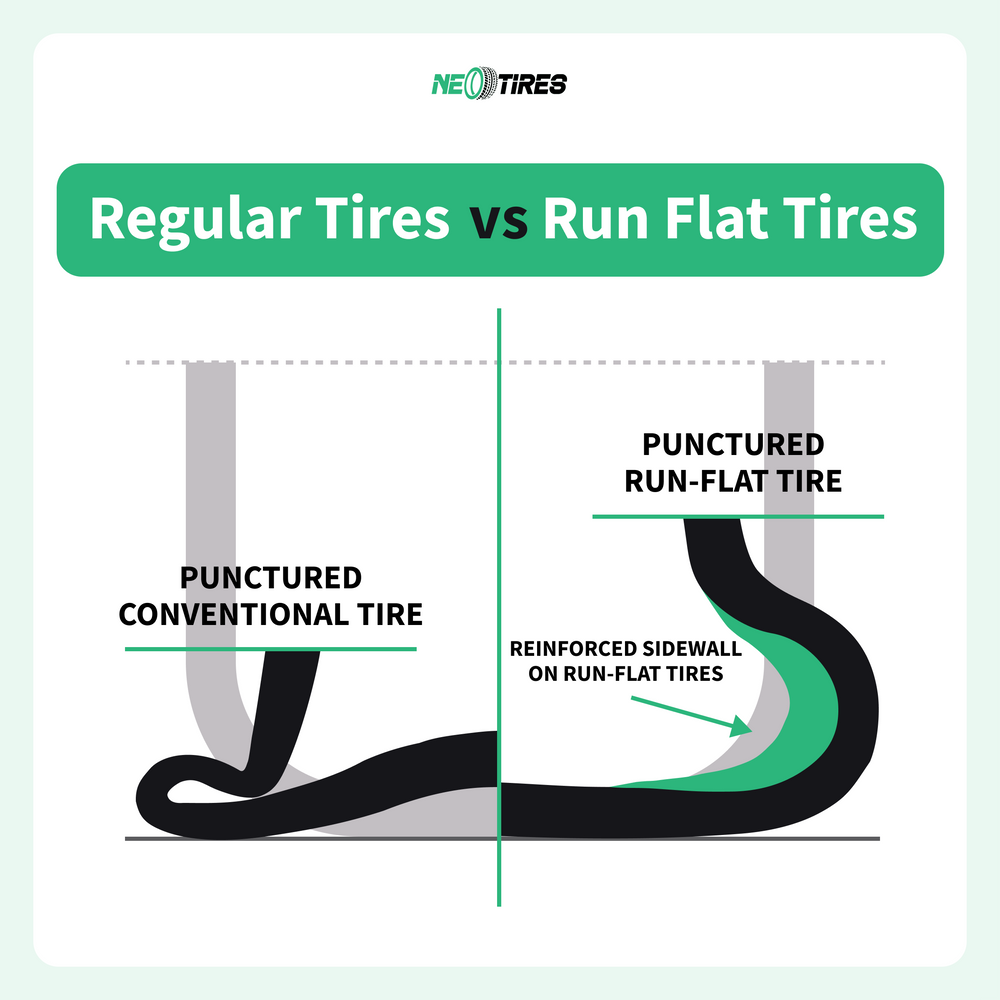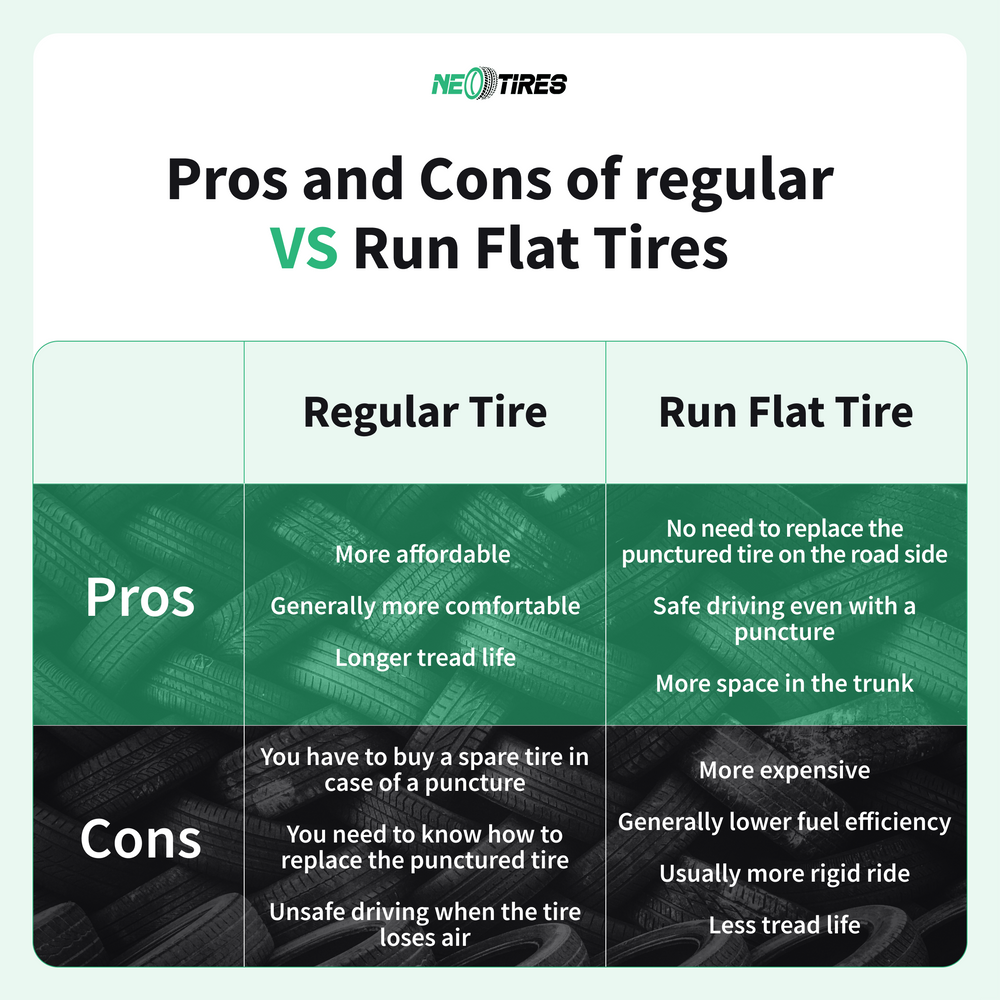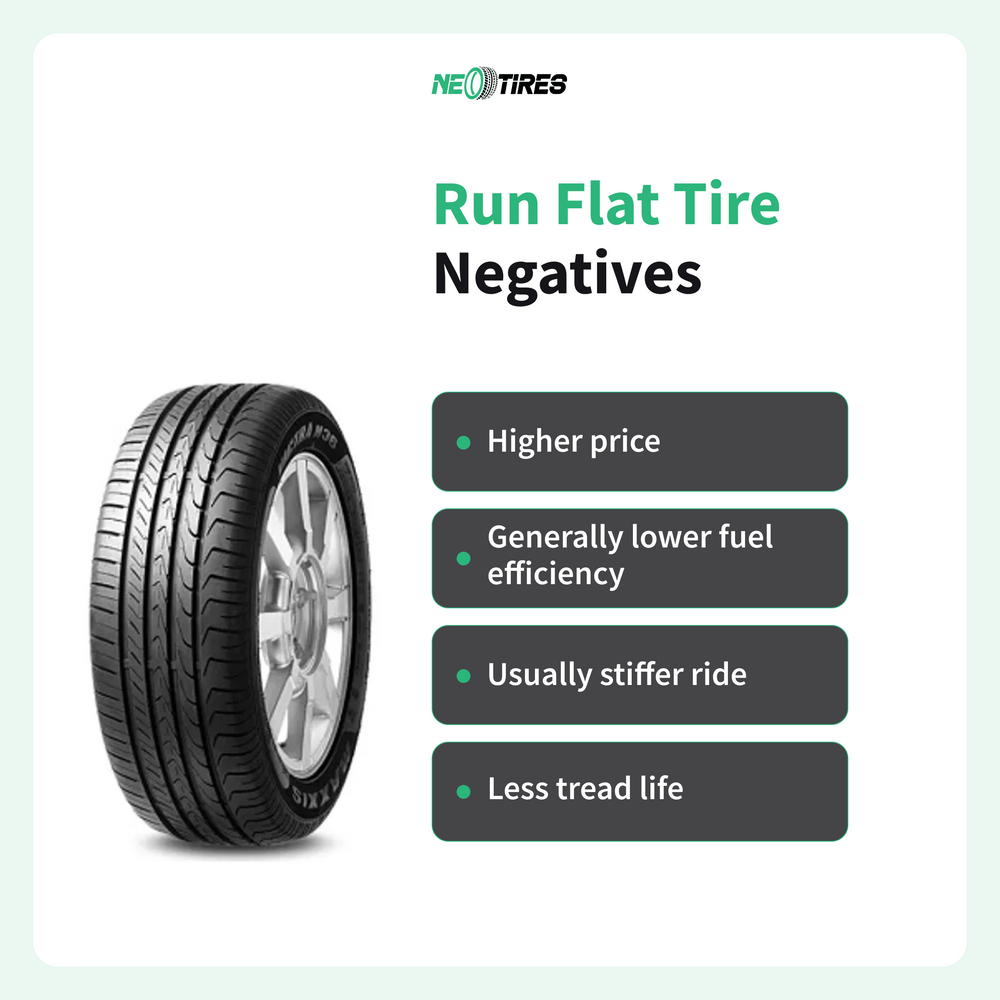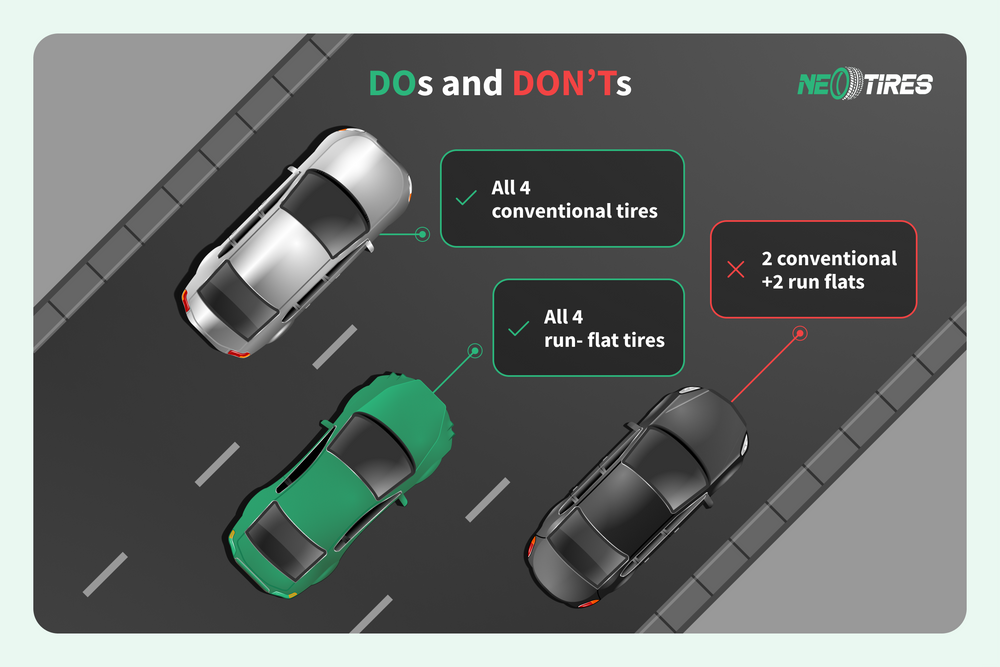When it comes to changing car tires, many car enthusiasts will suggest you consider run-flat tires. Those who have long been followers of this type of tire will tell you a lot about the beneficial impact these tires have on ride safety. Others will argue that there are no better tires because they propose an increased rear trunk loading volume as the spare tire is missing. And some additional space in the trunk is always a great idea.
However, if you do a little research on Google, you will discover that many drivers actually complain about the fact that run-flat tires do not provide the same comfort as regular tires. More than that, they are less budget-friendly as you will have to take a handful of money out of your pocket to maintain and change them.
And yet, which of these arguments is closer to the truth? Are flat tires a good option for your car or not? What are their advantages and disadvantages? And do their pros prevail over their cons? It's time to know everything about run-flat tires, as well as the benefits and shortcomings related to them. So let's roll up our sleeves and get to work.
Run-Flats: What Are They and How Do They Differ From Regular Tires?
Let's take into account the fact that not all car lovers know what "a run-flat tire" actually means. For this reason, I will start with the definition of this term, so that things get clear for everyone.
So what do these mean? Run-flat tires refer to tires with which you can continue the ride even if they have undergone a puncture. With ordinary tires, driving would be impossible in the context of a tire puncture because they would deflate and get severely damaged, including the wheel rim damage as well. With run-flat tires though, the whole wheel construction, including the tire surrounding it, is kept in optimal condition. Therefore, you have enough time to get to the closest service for a tire change.
In such circumstances, the first and most crucial benefit you get from run-flat tires is that these keep you away from severely damaging your wheels. That's because they preserve their initial rigid structure despite the loss of pressure due to a puncture.
How Long Can You Ride With a Run-Flat Tire?
Of course, you can't drive for too long. Sorry to spoil your expectations, but there is a definite period allowed to drive the car with run-flat tires in the context of a puncture. In most cases, you can drive around 80 km distance at a maximum speed of 80 km per hour.
However, each manufacturer sets its own speed and distance standards. So, I recommend checking the manufacturer's instructions in case you decide on this type of tire. Either way, be sure that you have enough distance at your disposal to get to a service with your punctured tires.
Run-Flat Tire Specs
I assume that you are curious to know what factors make the run-flat tires resistant to puncture. The answer lies in sidewalls that are reinforced in the run-flat type of tires. They have a specific construction that does not allow them to come off the rim. At the same time, the reinforced sidewalls allow these tires to keep their rigid shape throughout the ride.
The tire sidewalls are so thick that they easily withstand the pressure drop caused by the puncture. In such circumstances, these tires take all the load on themselves to protect the wheel and rim. However, following this significant load, they deteriorate so seriously that technicians can rarely repair them after the allowed distance following the puncture.
The good part of things is that with such tires, the spare tire that takes up quite a lot of space in the trunk makes no sense anymore. For some drivers who love to travel by car, this benefit is so comfortable that none of the disadvantages related to run-flat tires scare them anymore.
Types of Run-Flat Tires
Manufacturers produce 2 types of run-flat tires in the modern auto industry. It is about self-supporting tires and auxiliary-supported tires. While the names somehow suggest their principle of operation, let's talk about them more in detail.
When we talk about auxiliary-supported tires, we are referring to those that, unlike a traditional tire, have a special set of rims that include a ring of either rigid rubber or steel within them. Namely, this steel ring is the one that supports the weight of the car body, when the tire pressure drops drastically after a puncture. Alternatively, motor experts refer to the "auxiliary-supported tires" term by using the "support ring system" expression. Both refer to the same principle of activity.
Is Run-Flat Tire Really Worth It?
Self-supporting tires, or self-supporting systems, refer to the fact that the tire itself is made of a material so durable and hard that it supports the weight of the car body by itself. It needs no steel ring inside because the tire wall is tough enough to withstand the car's weight in the context of tire pressure drop. In modern cars, this system comes along with a tire pressure monitoring system. This system keeps the driver up-to-date about the tires' condition.
Now that you know everything about run-flat tires, I assume you are curious to find out what their advantages and disadvantages are. I recommend that you take them all into account to decide how beneficial they can be for your needs.
Run-flat Tires Advantages
From my own experience and from the dozens of discussions I had with other specialists in the field, I deduced at least 5 benefits that encourage the use of run-flat tires. It may seem too little to you. But the benefits are quite weighty. The first of them refers to the possibility of keeping driving, even with a busted wheel.
Keeping Driving, No Matter What
Starting from their basic purpose, run-flat tires allow you to continue the ride, regardless of your tire's condition. This advantage is the most relevant and is what makes run-flat tires a priori different from traditional tires. Imagine the consequences of a sudden blowout of a traditional tire. It certainly increases the risk of a serious accident that endangers your life and not only.
Even in milder circumstances, where the risk of accidents is not high, sudden tire blowout creates major discomfort. Imagine yourself changing the tire right in the middle of the road without having the possibility to call a service center. Not exactly the most optimistic scenario, is it?
Run-flat tires give you absolute control over driving, ensuring a safe ride from point A to point B. The risk of a potential accident is reduced to a minimum because the car is able to continue the route even with a defective tire. Even if the distance you can cover is not more than 100 km, this is statistically more than enough to reach a technical service center or at least a garage. So you have much more control over your ride.
Run-flat Tire Durability
Imagine how strong and durable these tires must be to withstand the weight of the car body. This speaks of their durable material that resists not only weight but also extreme conditions of temperature or roads. They will withstand the ultimate circumstances without thinking about the need for a spare tire.
Safety
Have you ever found yourself with a flat tire while driving at a pretty decent speed? If not, I hope you never go through something like that. The experience is not the most pleasant one.
Once the usual tire bursts, the pressure suddenly drops, generating a strong shock to the passengers and the driver of the car. If the driver lacks enough driving experience, he may lose control of the vehicle. The car is vulnerable to a slip off the road, posing a threat to passengers' lives.
In the case of run-flat tires, such surprises are unlikely. The pressure in the tires drops without severely impacting the course of the vehicle.
In this context, we can assume that run-flat tires provide a safer drive compared to traditional tires. And safety is a mandatory aspect that we have to consider while driving.
Space-efficient
Considering that keeping a spare tire in your trunk is no longer necessary, your vehicle will become a bit more space-efficient. This is a pleasant bonus for those who are used to traveling with their car and using their trunk to the maximum.
Time-saving tires
What do you do if your regular tires get flat on the way to an important event so you don't have to be late? As you can imagine, tire replacement in the middle of the road will ruin all your plans. Instead, run-flat tires allow you to postpone their replacement for later, while you solve your more priority questions.
All these benefits sound very promising. Many drivers rely on them, without being somehow affected by their shortcomings. Discover the disadvantages of run-flat tires to understand how beneficial they are for your preferences and needs.
Run-flat Tires Disadvantages
It would have been naive to think that run-flat tires bring benefits only. Everything has a price and the advantages of this type of tire are paid for with the following disadvantages.
Less Driving Comfort
You already know that run-flat tires assume a rigid and stiff structure. While this is necessary to maintain the weight of the vehicle, this stiffness severely impairs driving comfort. And this disadvantage is felt and confirmed by all those who have at least once touched a run-flat tire car.
The rigid architecture of these tires makes passengers feel every pebble and pothole on the road. At the same time, they do not inhibit the noise at all, generating an unbearable noise in the cabin. Manufacturers are implementing new noise suppression techniques in modern run-flat tires. It seems that these indeed reduce the noise to a certain extent. However, they continue to generate a highly uncomfortable ride.
Higher Expenses
Run-flat tire enthusiasts pay more for them. They are available at a higher price in the automotive industry as opposed to regular tires. It is no wonder that car lovers opt for traditional tires, considering that they can save around 30%-40% on the price while enjoying a very promising performance.
At the same time, the weight of run-flat tires is higher than regular ones. Consequently, it generates an additional effort for the transmission system to run on the road. Accordingly, the car consumes more fuel.
While the difference in fuel consumption is not significant on short distances, long rides will make the driver feel more fuel consumption.
Subsequent Repair is Usually Impossible
In most cases, the run-flat tires resist only one mission once the tires get punctured. That is, once they have traveled pressure-free the distance recommended by the manufacturer, they deteriorate severely. Imagine how much resistance they put up to maintain the weight of the body. As a consequence, their condition becomes deplorable and it is almost impossible to restore them to a decent condition. Most manufacturers do not embrace the idea of reusing them once they undergo puncture. In this context, they recommend their replacement, for which the owners have to pay a pretty high price. See the best run-flat options when needed.
The Distance is Sometimes Insufficient
Even if run-flat tires ensure a fairly stable course, the 80 km you can cover with punctured tires can sometimes be insufficient. Depending on the routes you ride, there may be no garages or service centers within a radius of 80 km. In such conditions, a spare wheel would really be welcome to rescue the situation.
Weather-Dependent Tires
Like it or not, run-flat tires do not like wet, slippery, and low-temperature circumstances. These are closer to summer tires than winter tires. Run-flat tires cannot boast of a sustainable grip, making the car lose stability and road control in wet or icy conditions. So what I said about stability in the advantages section is valid only in conditions of mild and relatively dry temperatures.
Run-Flat or Regular Tires?
Both types of tires come with a set of benefits and drawbacks. The decision in favor of one or the other must be based on your personal needs. If road safety takes priority over comfort, then run-flat tires are a great option. If comfort while driving is what matters the most to you, then for sure traditional tires will be much more to your liking. So you decide which suits you better, taking into account the benefits and disadvantages of each of them.
Some drivers swear that the benefit of safe driving with a punctured tire is all that matters, even if it involves additional costs. I agree with them because road safety is always my number one priority for me. However, let's not forget that manufacturers produce amazing traditional tires that provide superb traction as well as phenomenal grip in the most extreme circumstances. So, choose wisely in favor of what is most important to you.
Best Run-Flat Tires
Run Flat Tires: FAQs
Is it Good to Have Run-Flat Tires?
The biggest benefit of run-flat technology is that you don't have to replace the punctured tire by the roadside. This offers the possibility to keep driving safe and sound until a service center. This advantage entails small shortcomings such as a little stiffer ride, and higher price. But these disadvantages are not critical compared to the comfort of being able to keep driving on a flat tire. So, yes, a run-flat tire is a good idea to think about whenever you know what its disadvantages are and they don't bother you too much.
Can I Change the Run Flats to Normal Tires?
Most vehicles are compatible with both regular and run-flat tires. Drivers have no restrictions between switching from regular to run flats or vice versa. Technically, this is possible, but it's necessary to take into account the manufacturer's recommendations. What is really important is that the new tires correspond to the size of the wheels. Also, it is not advisable to mount only 2 regular tires. If you go from run flats to regular tires or vice versa, you have to change all 4.
Does BMW Recommend Run-Flat Tires?
BMW is a diehard promoter of run-flat tires. This carmaker equips most of its vehicles with run-flats. According to BMW's philosophy, driving is about safety, first and foremost. In this context, run-flat tires meet this goal better than any other type of tire, even if the ride stiffness disadvantage is a bit disturbing for some drivers. However, drivers have every right to opt for regular tires on their BMWs if these comfort them more.
Is it OK to Use Non-Run-Flat Tires for BMW?
Even if most BMW cars come equipped with run-flats from the factory, drivers can change them on regular tires. What really matters is to pay attention to the size of the new regular tire so that it is compatible with the load of the vehicle and the specifics of the rim. Also, drivers should learn more about the pros and cons of regular tires vs run-flats to make a correct decision.
Do Run Flats Wear Faster?
According to statistics and driver reports, run-flat tires tend to wear out faster than regular ones. While normal tires focus on longevity, run-flats focus on resistance. To increase the resistance, it seems that the manufacturers have to sacrifice their lifespan. As a rule of thumb, a run-flat tire lasts an average of 6,000 miles less than a traditional one. However, this also depends on the driving conditions and style. As such, run-flat service life is more of a disadvantage than a benefit.
Do Run-Flat Tires Use More Fuel?
As a rule, run-flats are somewhat more economical than regular tires, even if the difference is not considerable. Their fuel efficiency is explained by lower profile and respectively lower rolling resistance. The lower the resistance, the more fuel-efficient the tire is.
Why Trust Us?
Here you have a couple of reasons that would make you give us credit:
- Neotires has been on the market for 5 years, but each member of the team has about 7-10 years of experience in the automotive and tire industry;
- Selling tires is a secondary goal for us; the primary goal is to match drivers' needs with the right tires;
- We test, review, and compare tires on our own in our technical center to provide reliable and trustworthy information to the end customer;
- We collaborate closely with reputable tiremakers to provide the best deals;
- We train and develop ourselves to deliver high-quality service, assistance, and products to all drivers out there;
- We love tires, driving, performance, and new technologies from the automotive industry. This makes us love our job madly and assist our customers'' needs with passion.




